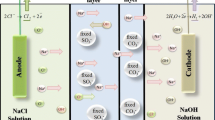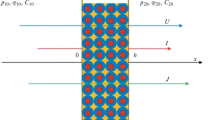Abstract
Within the framework of the mathematical model of Nernst-Planck-Poisson, an attempt is undertaken to theoretically describe the electrodiffusion of ions in the system diffusion layer/monopolar ionexchange membrane, which is accompanied by dissociation of water molecules. The formulas for estimating the current density transferred through a monopolar membrane by hydrogen or hydroxyl ions formed in dissociation of water in the space-charge region are derived. The rate constants and other parameters of dissociation of water molecules in the space-charge region of monopolar membranes under conditions of stabilization of the diffusion layer thickness are calculated. Their comparative analysis with the similar characteristics of bipolar membranes is carried out. For the phosphoric-acid heterogeneous membrane MK-41 in which the polarization conditions in the current density range under study are not so severe and the reaction layer is not being depleted as in the bipolar membrane MB-3 (contains the same phosphoric-acid groups), it is shown that only single-charged phosphoric-acid groups are involved in the water dissociation reaction. For MK-41, the calculated constants of the heterolytic reaction of water molecule dissociation are lower than for the heterogeneous membrane MA-40 containing ternary and quaternary amino groups. It is confirmed that the nature of ionogenic groups in membranes is a factor that determines the rate of water dissociation in systems with ion-exchange membranes.
Similar content being viewed by others

References
Kressman, T.R.E. and Tye, F.L., J. Electrochem. Soc., 1969, vol. 116, no. 1, p. 25.
Grossman, G., J. Phys. Chem., 1976, vol. 80, no. 14, p. 1616.
Turner, J.C.R., in Polarization in Electrodialysis. Proc. VI Int. Symp. on Fresh Water from the Sea, Las Palmas, Athens, 1978, vol. 3, p. 125.
Simons, R. and Khanarian, G., J. Membr. Biol., 1978, vol. 38, p. 11.
Simons, R., Nature, 1979, vol. 280, p. 824.
Greben’, V.P., Pivovarov, N.Ya., Kovarskii, N.Ya., and Nefedova, G.Z., Zh. Fiz. Khim., 1978, vol. 52, no. 10, p. 2641.
Zabolotskii, V.I., Shel’deshov, N.V., and Gnusin, N.P., Elektrokhimiya, 1979, vol. 15, p. 1488.
Simons, R., Electrochim. Acta, 1984, vol. 29, p. 151.
Timashev, S.F. and Kirganova, E.V., Elektrokhimiya, 1981, vol. 17, p. 440.
Tanaka, Y. and Seno, M., Denki Kagaku, 1983, vol. 51, no. 2, p. 267.
Kharkats, Yu.I., Elektrokhimiya, 1985, vol. 21, p. 974.
Zabolotskii, V.I., Shel’deshov, N.V., and Gnusin, N.P., Usp. Khim., 1988, vol. 57, p. 1403.
Mauro, A., Biophys. J., 1962, vol. 2, p. 179.
Kirganova, E.V., Timashev, S.F., and Popkov, Yu.M., Elektrokhimiya, 1983, vol. 19, p. 978.
Umnov, V.V., Shel’deshov, N.V., and Zabolotskii, V.I., Russ. J. Electrochem., 1999, vol. 35, p. 871.
Umnov, V.V., Shel’deshov, N.V., and Zabolotskii, V.I., Russ. J. Electrochem., 1999, vol. 35, p. 411.
Rubinstein, I. and Shtilman, L., J. Chem. Soc., Faraday Trans. 2, 1979, vol. 75, p. 231.
Urtenov, M.Kh. and Nikonenko, V.V., Elektrokhimiya, 1993, vol. 29, p. 239.
Urtenov, M.Kh., Kraevye zadachi dlya sistem uravnenii Nernsta-Planka-Puassona (asimptoticheskie razlozheniya i smezhnye voprosy): Monografiya (Boundary Problems for Systems of Equations of Nernst-Planck-Poisson (Asymptotic Expansions and Related Problems: Monograph), Krasnodar: Kuban GU, 1999.
Shaposhnik, V.A., Kastyuchik, A.S., and Kozaderova, O.A., Russ. J. Electrochem., 2008, vol. 44, p. 1073.
Zabolotskii, V.I., Sharafan, M.V., and Shel’deshov, N.V., Russ. J. Electrochem., 2008, vol. 44, p. 1127.
Zabolotskii, V.I. and Nikonenko, V.V., Perenos ionov v membranakh (Ion Transfer in Membranes), Moscow: Nauka, 1996.
Zabolotskii, V.I., Sharafan, M.V., Shel’deshov, N.V., and Lovtsov, E.G., Russ. J. Electrochem., 2008, vol. 44, p. 141.
Zabolotskii, V.I., Shel’deshov, N.V., and Sharafan, M.V., Russ. J. Electrochem., 2006, vol. 42, p. 1345.
Levich, V.G., Fiziko-khimicheskaya gidrodinamika (Physicochemical Hydrodynamics), Moscow: Fizmatgiz, 1959.
Author information
Authors and Affiliations
Corresponding author
Additional information
Original Russian Text © V.I. Zabolotskii, M.V. Sharafan, N.V. Shel’deshov, 2012, published in Elektrokhimiya, 2012, Vol. 48, No. 5, pp. 603–608.
Rights and permissions
About this article
Cite this article
Zabolotskii, V.I., Sharafan, M.V. & Shel’deshov, N.V. The dissociation rate of water molecules in systems with cation- and anion-exchange membranes. Russ J Electrochem 48, 550–555 (2012). https://doi.org/10.1134/S1023193512040131
Received:
Published:
Issue Date:
DOI: https://doi.org/10.1134/S1023193512040131



